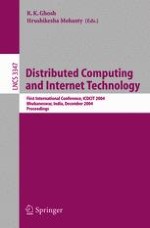2005 | Buch
Distributed Computing and Internet Technology
First International Conference, ICDCIT 2004, Bhubaneswar, India, December 22-24, 2004. Proceedings
herausgegeben von: R. K. Ghosh, Hrushikesha Mohanty
Verlag: Springer Berlin Heidelberg
Buchreihe : Lecture Notes in Computer Science
